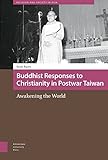Buddhist Responses to Christianity in Postwar Taiwan : Awakening the World / Scott Pacey.
Material type: TextSeries: Publication details: Amsterdam : Amsterdam University Press, (c)2019.Description: 1 online resource (244 pages)Content type:
TextSeries: Publication details: Amsterdam : Amsterdam University Press, (c)2019.Description: 1 online resource (244 pages)Content type: - text
- computer
- online resource
- 9789048544424
- 9048544424
- BR128 .B833 2019
- COPYRIGHT NOT covered - Click this link to request copyright permission: https://lib.ciu.edu/copyright-request-form
| Item type | Current library | Collection | Call number | URL | Status | Date due | Barcode | |
|---|---|---|---|---|---|---|---|---|
 Online Book (LOGIN USING YOUR MY CIU LOGIN AND PASSWORD)
Online Book (LOGIN USING YOUR MY CIU LOGIN AND PASSWORD)
|
G. Allen Fleece Library ONLINE | Non-fiction | BR128.8 (Browse shelf(Opens below)) | Link to resource | Available | on1167752153 |
Browsing G. Allen Fleece Library shelves, Shelving location: ONLINE, Collection: Non-fiction Close shelf browser (Hides shelf browser)
Includes bibliographies and index.
COPYRIGHT NOT covered - Click this link to request copyright permission:
https://lib.ciu.edu/copyright-request-form
Cover -- Table of Contents -- Acknowledgments -- A Note on Romanization and Translations -- Preface -- Introduction -- Chinese Buddhism and identity -- The three teachings -- Buddhism and Christianity in China -- New intellectual and political responses -- Enter the KMT -- Modernity, and "KMT modernity" -- Taixu -- Overview of the study -- 1. Buddhism and Patriotism -- Taiwan's Political Context -- Buddhism and KMT Values -- Awakening the world -- Conclusion -- 2. Buddhism and Chinese Culture -- Cultural renaissance -- From Moses to Marx -- "Slave society" -- East of Eden
The genesis of a new approach -- The study of Buddhism -- Conclusion -- 3. Buddhism and Modernity -- Pointing at the moon -- Open letters to Du -- The science of Sakyamuni -- God and Gotama -- Yinshun's sources -- Conclusion -- 4. Decline and Revitalization -- Perceiving the decline -- History as polemic -- From the temple to the ivory tower -- Conclusion -- 5. Sermons Among Mountains -- Dharma Drum Mountain -- Tzu Chi -- Buddha-Light Mountain -- Lingjiu Shan and Zhongtai Chansi -- Conclusion -- Conclusion -- Religious inter-connectivity -- Interfaith competition in Taiwan after 1949
KMT modernity -- Interfaith competition and identity -- List of Chinese Characters -- Bibliography -- Index
After the Communist victory in China's civil war, Taiwan-then governed by the KMT (or Nationalist Party)-became a focal point for both Buddhist and Christian activity in the Chinese world. Between the mid-1950s and 1970s, Buddhists responded to subsequent Christian growth on the island. This occurred against a backdrop of intense Christian proselytization, and Buddhist concern for the future viability of their tradition. [-][-]Focusing on some of the most influential monastics of the time, this is the first study to provide in-depth coverage of Chinese Buddhist-Christian engagement after 1949. Drawing on Buddhist and Christian publications, it shows that interfaith competition, and political context, are important in shaping religious identity, and driving the religious engagement with modernity. This book will be of interest to historians of Buddhism, Chinese religion and Taiwanese society, and to those with an interest in interfaith dialogue more generally.[-.
There are no comments on this title.







